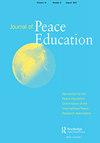Teaching peace and conflict: the multiple roles of school textbooks in peacebuilding
IF 0.7
Q3 EDUCATION & EDUCATIONAL RESEARCH
引用次数: 1
Abstract
authors clearly ground their work in robust theories and frameworks to revisit the intertwine of peace and human rights. The authors are also successful in provoking us, the readers, to accept the idea that PE and HRE are non-separable, and therefore they need to be taught together that peace cannot be gained unless justice is served first. However, from the pedagogical dimension, implementing PHRE may not be easy. Even as an independent field, teachers are still struggling in teaching peace and human rights in the classrooms. Their pedagogical practices are mostly based on personal perceptions with a lack of legal knowledge and an uncertainty to overcome daily injustice or racism (Osler and Skarra 2021). It is also difficult to ask the students to keep in peace, while they are also taught to fight for their basic rights. We know that conflicts and wars are mostly caused by injustice or the imbalance in rights distribution affecting the absence of peace within this situation. In other words, it is difficult to put peace and human rights side by side. As a teacher myself, I imagine the practice of PHRE is a practice of pouring water and fire at the same time: (almost) impossible. Despite these concerns, this book is essential for those within the fields of PE and HRE. Future researchers, policymakers, and activists can use the book as a starter for them in deciding future studies and making educational policies. Although it might be challenging, teachers and practitioners from various educational contexts and settings may find it a useful resource, particularly as a practical guide to teach peace and human rights together in the classrooms.和平与冲突教学:学校教科书在建设和平中的多重作用
作者们清楚地将他们的工作建立在强有力的理论和框架之上,以重新审视和平与人权的交织。作者还成功地促使我们读者接受体育和人权教育是不可分离的,因此需要共同教育他们,除非首先伸张正义,否则就无法获得和平。然而,从教学层面来看,实施PHRE可能并不容易。即使作为一个独立的领域,教师们仍在课堂上努力教授和平与人权。他们的教学实践大多基于个人认知,缺乏法律知识,不确定如何克服日常的不公正或种族主义(Osler和Skarra 2021)。要求学生保持和平也很困难,同时他们也被教导为自己的基本权利而战。我们知道,冲突和战争主要是由不公正或权利分配不平衡造成的,这种不公正或不平衡影响到这种局势中缺乏和平。换言之,很难将和平与人权放在一起。作为一名教师,我认为PHRE的实践是一种同时倒水和生火的实践:(几乎)不可能。尽管存在这些担忧,但本书对体育和人力资源教育领域的人来说是必不可少的。未来的研究人员、政策制定者和活动家可以将这本书作为他们决定未来研究和制定教育政策的起点。尽管它可能具有挑战性,但来自不同教育背景和环境的教师和从业者可能会发现它是一种有用的资源,特别是作为在课堂上共同教授和平与人权的实用指南。
本文章由计算机程序翻译,如有差异,请以英文原文为准。
求助全文
约1分钟内获得全文
求助全文

 求助内容:
求助内容: 应助结果提醒方式:
应助结果提醒方式:


